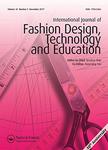版权所有:内蒙古大学图书馆 技术提供:维普资讯• 智图
内蒙古自治区呼和浩特市赛罕区大学西街235号 邮编: 010021

作者机构:Fashion Merchandising Program Human Ecology Department Youngstown State University Youngstown OH 44555 One University Plaza United States Fashion Design and Merchandising Program SIUC Carbondale IL United States Design Texas Tech University Lubbock TX United States
出 版 物:《International Journal of Fashion Design, Technology and Education》 (Int. J. Fash. Des. Technol. Eudc.)
年 卷 期:2013年第6卷第3期
页 面:173-180页
主 题:fashion involvement fashion leadership garment quality gender
摘 要:How consumers evaluate garment quality affects consumers decision-making, hence it is imperative to study how consumers evaluate quality. The purpose of the study was to contribute to a better understanding of how consumers evaluate garments and how variables such as fashion leadership, fashion involvement, and gender influence garment evaluation. Participants were 309 students from two Midwestern universities. A convenient stratified sample was used. The Garment Quality Evaluation Scale (GQES) was used to measure garment quality, the measure of fashion innovativeness and opinion leadership was used to subdivide participants into fashion leaders and fashion followers, and the Fashion Clothing Involvement Scale was used to divide participants into high and low fashion-involved consumers. MANOVA (multivariate analysis of variance) and ANOVA (analysis of variance) results indicated that how consumers evaluated garment quality was significantly influenced by fashion leadership, fashion involvement, and gender. This study makes an important contribution in understanding garment quality evaluation by consumers. © 2013 © 2013 Taylor & Francis.